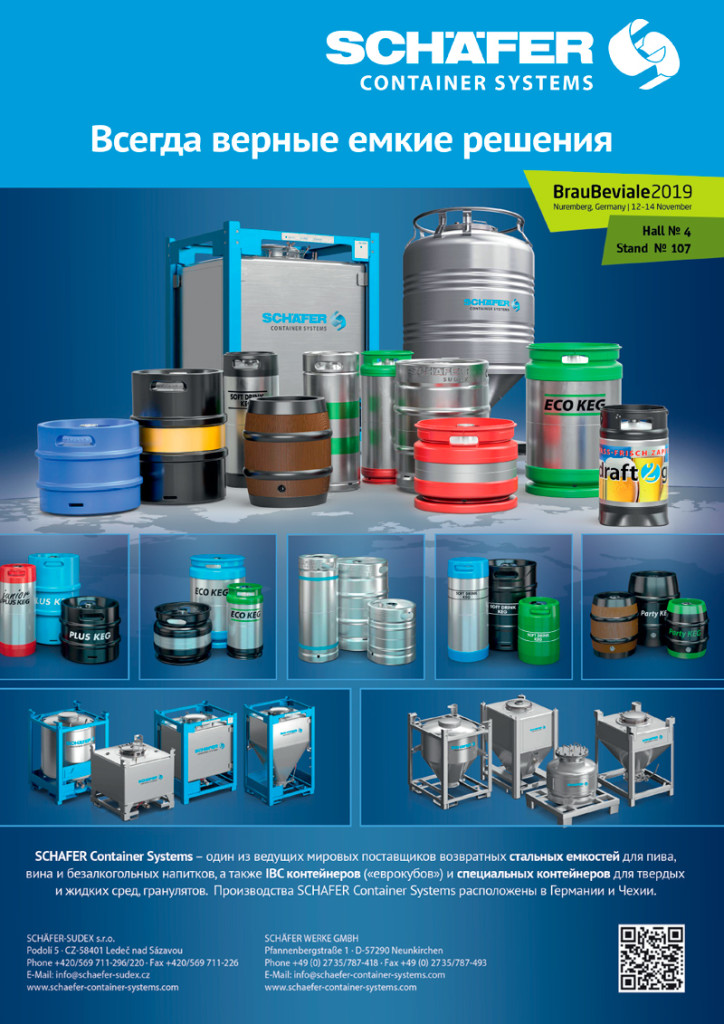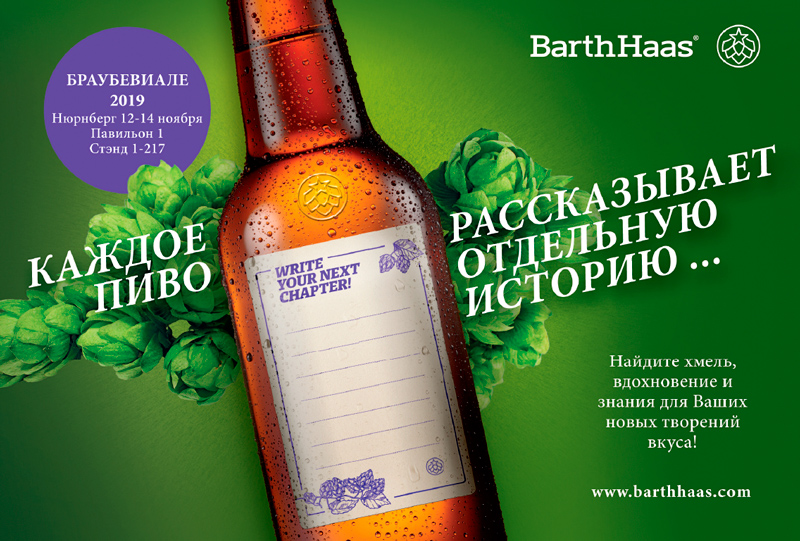During the first half of 2019, the majority of Kazakh brewers made their contribution into positive dynamics. Yet it was companies of the lower division, not the two transnational leaders that raised their production and sales. The shares of draft beer and aluminum can which is rapidly squeezing glass bottle out of the market, have been growing. The price segmentation has remained stable despite the substantial rise of retail prices and fluctuations of brand market shares, while the borders between segments have become blurred. The main events in the industry have been: the announced revision of the beer excise policy, launch of BeerKhan brand in the strong beer segment, and most important – purchasing assets of Shymkentbeer by Arasan.
Brewing industry of Kazakhstan in numbers
According to operational data by statistics Agency RK, in the first half of 2019 the beer production in Kazakhstan went …% up. The beer output increased at all major Kazakh brewers. However, in third quarter the rates looked much weaker, as the official growth ran at …%.
One way or another, one can expect the year of 2019 to confirm the positive trend in the industry development which was observed during the last decade (with some fluctuations). Let us note that in 2018 the beer output grew by .% to ….. mln dal. Compound annual growth rate (CAGR) from …. to 2019 will equal nearly …% and …% from 2015 to 2019.
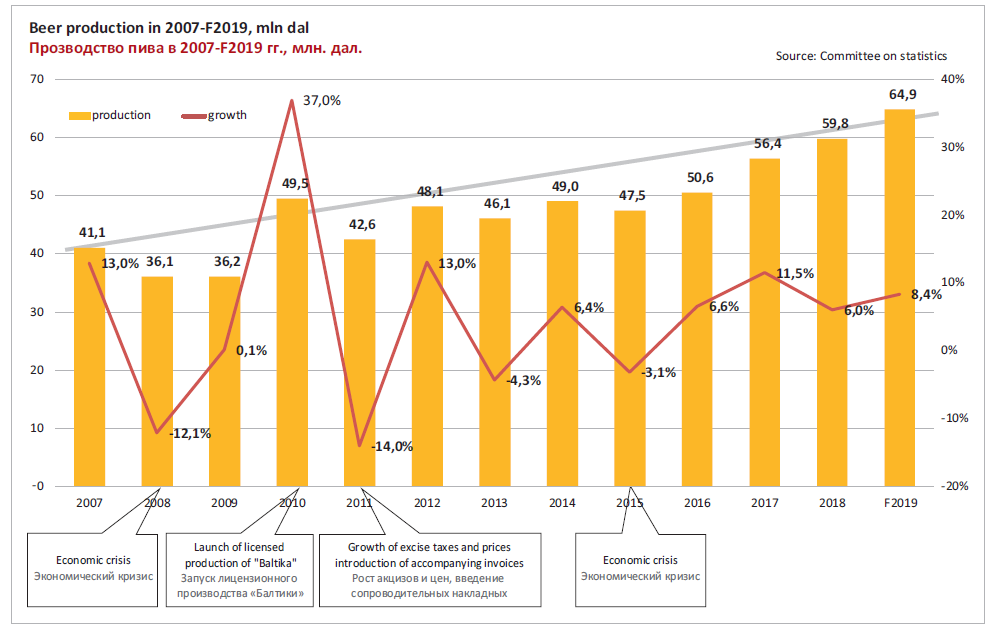
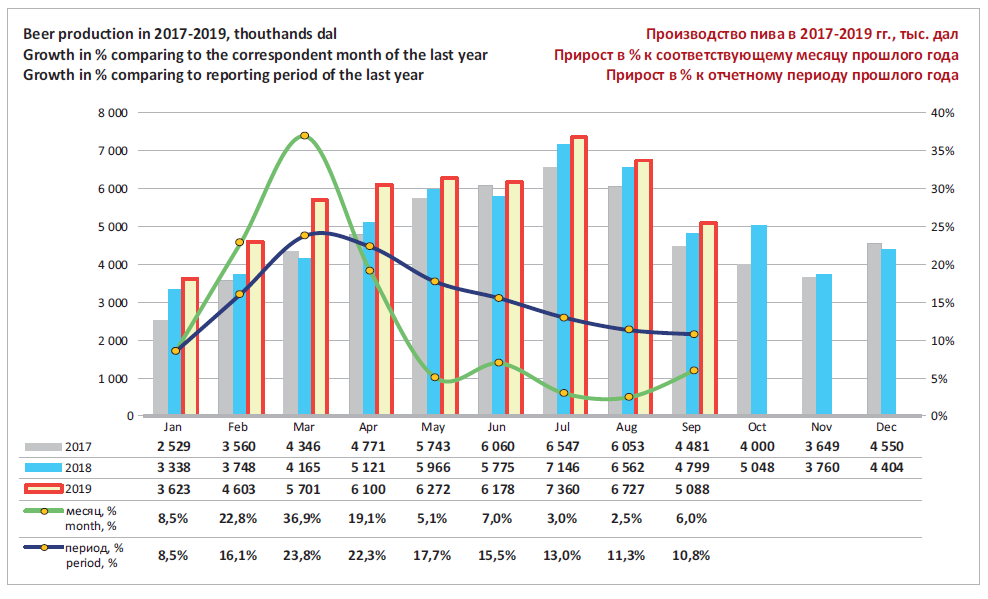
The producer’s prices that had been controlled during most of 2018, started to grow by the end of the year. It was mostly connected to substantial devaluation of tenge from May to September 2018 and subsequent wave of inflation.
For Kazakh brewers the devaluation was rather substantial as nearly a quarter of the general malt volume, all hop and a significant share of other materials are imported. Thus, in 2018, .. … tons of malt to the customs value of $…. mln (..% growth by volume and decrease by …% in dollars) as well as ……. tons of hop and dry hopproducts costing $…. mln (….% decline by volume and ….% rise in dollars) were imported to the republic.
As a result, average weighted cost prices of brewers in the first half of 2019, increased …% to … tenge for a liter against the same period of the previous year. Yet in dollars due to the devaluation the prices have not risen but declined by .% to .. cents for a beer liter. The main price rise of producer’s prices took place in November 2018, before the excise rise (by …..% to .. tenge for a liter).
Basing on the producer’s prices and the beer output one can approximately estimate brewers’ revenue. By the results of 2018 and corrected operated data, it increased by ….% to …… bn tenge (or by …% to $… mln). During the first half of 2019, the revenue growth in tenge accelerated to ….% but in dollars it was much smaller (nearly …%) and remained positive due to the output growth. Judging by the trends, as well as by the previous year base of beer production and tenge rate, by the end of 2019, the growth rates of revenue in tenge will be lower and it will remain at the same level or increase a little in dollars.
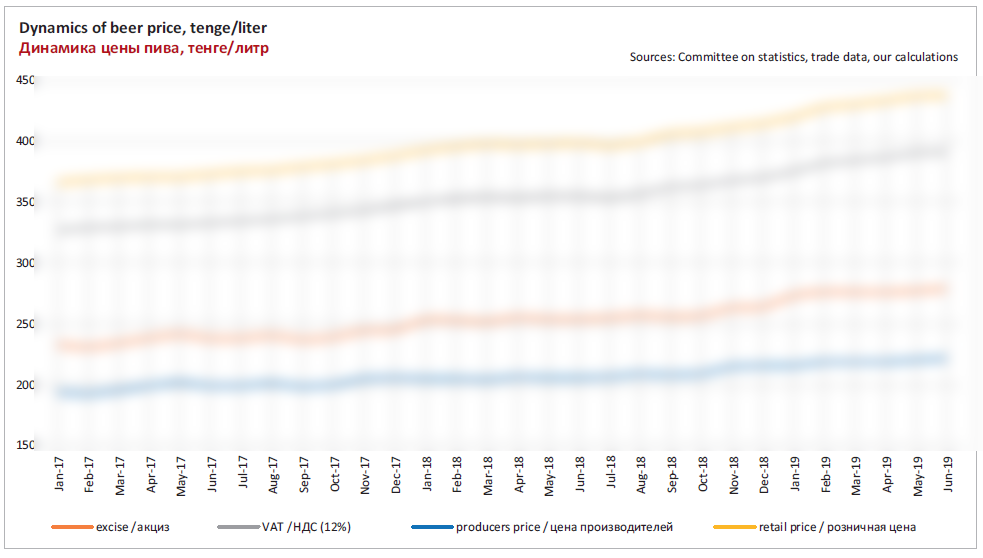
The rise of consumer prices for foods in the second half of 2018, increase of producer’s prices by brewers at the end of 2018 as well as the excise growth early in 2019, have together resulted in rather rapid and long-standing rise of retail prices for beer. It continued from August 2018 till May 2019. Over this period, the average price for one liter of packed beer on a shelf grew from … to … tenge. The average weighted price for one liter of beer in the first half of 2019 increased by …% to … tenge, yet, it decreased in dollars by …% to $…. for a liter.
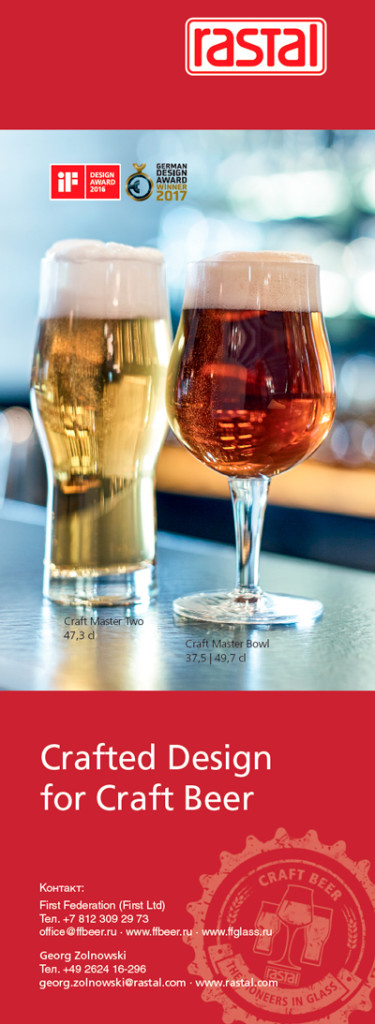 The import of beer over 2018 grew by ….% to …. mln dal*. Virtually all of the imported beer (..%) came from Russia. In its turn, the bulk of this volume was directed from Russian to Kazakh divisions of international brewing companies, mostly between divisions of … and ….
The import of beer over 2018 grew by ….% to …. mln dal*. Virtually all of the imported beer (..%) came from Russia. In its turn, the bulk of this volume was directed from Russian to Kazakh divisions of international brewing companies, mostly between divisions of … and ….
* In our review of the beer market of Kazakhstan in №4-2018 the factor of import was not taken in consideration, as official shipments long time were very scarce.
The rates of official export somewhat exceeded the rates of import, but in absolute figures there was much less beer exported than imported (the expert grew by ….% to … mln dal).
Estimated volume of the beer market in 2018 increased due to the import growth by ….% and amounted to …. mln dal. According to our rough estimation, during the first half of 2019 the import shipments stopped growing remaining nearly at the same level. So the market growth rates were approximately equal to the production growth rates.
If we base on the market value of packed beer, we’ll say that in 2018 the beer market by value increased by ….% to ….. bn tenge. In dollars, the growth ran at ….% to $….. mln. Yet the actual figures of the market growth can be lower than the estimated ones due to the presence of unofficial export of Kazakh beer to Russia.
During the first half of 2019, the inflation, the growth of excises and brewers’ costs led to rapid price increase for beer in retail, and to “puffing” of the market volume in the national currency by ….% (yet in dollars it only grew by …% because of the devaluation).
The market segmentation
As well as at the other markets of Eastern Europe, in Kazakhstan price rises for beer were coupled with blurring of price segments. This is taking place due to different price and branding policy of competing companies as well as to the major retail channel DIOT that is operating apart from the outlet channels of packed beer yet but influences its structure.
In particular, over 2019, two brands (out of two major ones) – … and … have become comparatively more affordable in their segments despite the price growth. The first brand is positioned at the border of the economy and mid-price segments, and the second one is between the premium and mid-price segments. Naturally, it is more difficult to assess the sizes of the segments due to the borderline positioning.
In order to keep continuity, let us consider … to be mainstream and … to belong to the premium segment. But one has to keep in mind that after the price rises in the second half of 2018, the gravity center inside the economy and mainstream segments has shifted down the price scale.
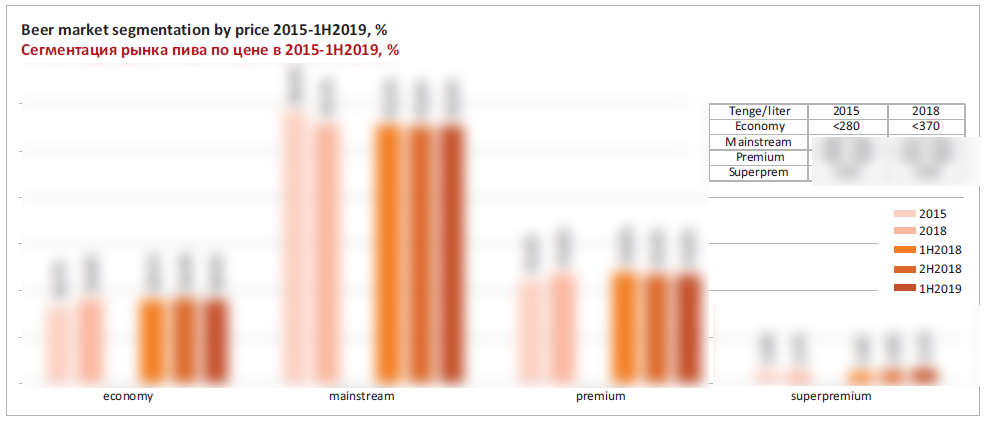
Though the shares of economy and mainstream segments technically did not change much in the first half of 2019, the situation inside them was changing rather dynamically, as some brands were increasing their shares, while others on the contrary experienced (see chapter on companies’ positions). …p.p. decline of the premium segment resulted from the market share decrease of major brand … and was fully balanced by growth of superpremium segment by … p.p.
Judging by the industry data on the volumes of four major companies and our rough estimations of the output structures at small breweries, we can assess the market segmentation by package.
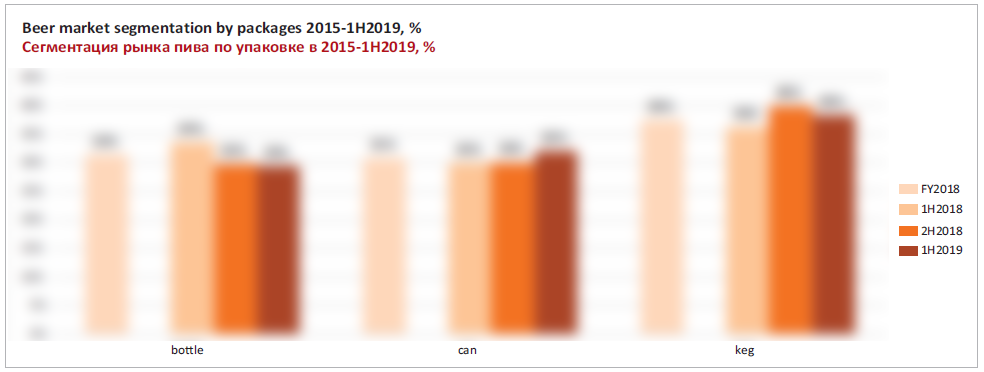
By the end of 2018, one can estimate the draft beer sales at nearly .. mln dal. and its share at ..% (the psychological barrier of ./. of the market had been overcome by the draft beer in 2017). In 2019 it has been enjoying further popularity growth. Against first half of 2018, the share of the draft beer has increased by . p.p. to ..%. By volume, the sales of keg beer have exceeded the market as their volume increased by ..%.
The draft beer sales are thriving thanks to riot development of DIOT (Draft In On Trade). According to .GIS data, by the end of 2018, in ten major cities of Kazakhstan there were …. shops selling draft beer and located separately from other shopping facilities. In the average in seven cities* in 2018 the growth of the outlet number reached ..% as there appeared much more outlets at new locations than closed at old ones. And the total number of draft beer outlets in Kazakhstan amounts to at least ….. Their estimated volume of beer realization can be placed at more than .. mln dal per year.
*Comparing the number of outlets in 2017/2018 is possible for seven cities Almaty, Nur-Sultan, Karaganda, Shymkent, Pavlodar, Uralsk and Aktau. The estimation of the number growth can be distorted by the fact than not all outlets had been included into 2GIS database in 2017.
By the end of 2018 the sales of packed beer can be estimated at .. mln dal. Its share in the first half of 2019 decreased by . p.p. to ..%. By volume, packed beer grew by .%.
At the same time sales of beer in glass bottle were transforming into sales of canned beer. During the first half of 2019, the beer market share of glass fell by . p.p. to …%. The can share over the same time grew by . p.p. to …%.
In the structure of packed beer sales the share of package of usual volume ….-…. l has rather steadily kept …%. Non-standard packages of glass and aluminum of bigger volume (up to … l) accordingly have nearly …% of the segment.
In Kazakhstan unlike Russia or Ukraine non-alcohol beer does not enjoy big popularity. Its share on the packed beer market equals less than .%. Instead, the share of strong beer has increased by . p.p. to ..% since mid 2018 due to BeerKhan launch.
Excise anew
In 2017 and 2018 the excise rate for beer was growing predictably and moderately – by . tenge for a liter per year. Brewers took the regulation positively in view of stimulating consumers to switch from strong alcohol to low alcohol as well as the possibilities for tax planning.
However, in the nearest future such approach can be changed as the excise pressure has increased considerably. In January 2019, Ministry of the national economy announced the conception of legislation on taxation and published it in May. In this big document beer is mentioned separately.
In chapter “Reinforcement of fiscal function of excises” highlights the priority of incremental rate of taxation on “luxuries” and unhealthy foods. It is suggested to fulfill this task by raising excise rates. In the first turn, the excise on beer and beer drinks is intended to be raised gradually starting from ….. This will allow levelling the conditions of taxation for alcohol drinks, as the authors of the conception consider. It is mentioned that the tap portion in beer and beer drinks is the smallest in alcohol and tobacco products in the Kazakh market. The current excise rate for beer and beer drinks in the Russian Federation is fixed at three grades according to alcohol content. At that the rates are much higher than those in Kazakhstan.
As we can see the grounding for the suggestions includes two reasons – unequal terms of competition with other alcohol drinks and unequal excise rates in Kazakhstan and Russia.
The first reason was spoken about in more detail by Amirzhan Kaliev, head of the industry association Kazalko that unites producers of strong alcohol and wine. Website of Brewers’ union of Kazakhstan has published an interview with him:
“By now a working party on introducing changes to the Tax code for the next three years – …., …. and …. has been formed in the Ministry of national economy. We intend to propose to retain growth of excises on strong alcohol or even freeze it at the level of the previous year”.
According to Kaliev, such suggestion can raise reasonable questions in the working party as to how to compensate for the missing taxes to the budget.
“If asked that, we can propose to enlarge the excise on beer. Currently, a beer in bottle is cheaper than juice, which is wrong. We think one has to pay for alcohol content in a bottle. For example, vodka producers will pay for .. degrees and beer producers will pay for .-. degrees. This would raise the excise for beer and could become a good alternative for budget replenishment.
While in 2018 a liter of vodka had an excise of … tenge, a liter of beer was levied with as much as .. tenge excise. If we divide … tenge by .. degrees, we will get ….. tenge for one alcohol containing degree. Beer in general has five degrees, so the excise should amount to … tenge for a liter, while currently it is only .., which is unfair.
Wine excise rates have not been changed for nearly .. years, and we should leave them as they are. As there is a pledge from the head of the country to refocus the population to low-alcohol beverages. Yet, I think the market situation allows changing the excise rates for beer”.
The second reason concerning the inequity of rates in Russia and Kazakhstan though not covered by the conception, has been many times discussed by industry organizations in Russia and intergovernmental councils.
One should note that members of Eurasian Economic Union have beer in talks to harmonize the excise rates starting from 2012. But no sooner than in late 2018, there appeared an announcement on general possibility to coordinate projects of tax policy as to excises on alcohol and tobacco production. At that time, the intergovernmental council made the first progress in harmonizing rates on cigarettes.
The problem was in the fast growth of the illegal cigarettes market share in the territories neighboring borders with Belarus and Kazakhstan. In particular, due to differentiated excise rates on tobacco products in Belarus, the cheapest category of cigarettes was delivered to the Russian and EU black markets at low prices. As the scenario of decreasing (or differentiation) of the excise for the Russian producers had hardly been discussed, the talks ended in unification at the level of .. euro for …. cigarettes with a deviation of no more than ..% upward or downward from …..
The situation with beer looks very similar. From Russian brewers at meetings of the industry union there have been a lot of complaints about illegal beer on bordering territories (both from Belarus and Kazakhstan directions). Besides, one can find a range of press messages about confiscation of such production at the border or by tax authorities of Federal service for alcohol market regulation in retail. Levelling of the excise rates would allow Russians to level the situation with illegal transborder trade.on, and looking for sources of budget replenishment in the conditions of unstable world oil prices, could make official establishment turn to twofold excise rise.
Leading companies’ positions
The changes in the companies’ positions are connected to expanding of Kazakh beer market in three aspects – import beer, daft beer segment and canned beer.

Efes Kazakhstan
The company still leads the pack in terms of beer output volumes. In 2018 it hit …. mln dal by our estimation.
Efes Kazakhstan’s performance looks two-way. In the second half of 2019, the company production dynamics was behind the industry average, and its share in the total output volume decreased by . p.p. Efes Kazakhstan beer output grew by …% but competitors with smaller operational scales were developing more rapidly than the leader, thus, the company so far has not managed to restore its share in the output volume.
According to the trend of draft beer growing popularity, Efes Kazakhstan’s sales in this segment were growing at two-digital rates, yet, even here the company was behind competitors. As Efes Kazakhstan imports comparatively small volumes of beer (about …. mln dal), foreign supplies have not much changed its sales.
Efes Kazakhstan’s focus on packed beer has somewhat shifted to the premium over the previous .. months. In general volume, the share of economy brands went down by . p.p. and the share of premium beer increased by . p.p. Accordingly the company has cut its presence in the economy segment of packed beer (by … p.p.) and in the mid-price segment (also by … p.p.) and has enlarged it in the premium segment by …p.p.
The company’s sales structure of packed beer is still dominated by the mass brand …. Its retail price was controlled while average beer prices were hiking and now it is close to economy brands. This allowed to expand the market share of the brand by … p.p. Yet at the same time, the share of another mainstream brand … went down by . p.p. following the growth in the second half of 2018. Owing also to minor growth of … market share, the company kept the stability in the mainstream segment (in case cheaper … is also formally included there).
Besides, after a significant growth in the second half of 2018, economy brand … went down to the previous share.
Most of premium and superpremium brands by the company such as …, …, …, … have increased their market share a little bit, and … on the contrary has lost a little. But in total the share of marginal beer in Efes Kazakhstan sales in the first half of 2019 was growing.
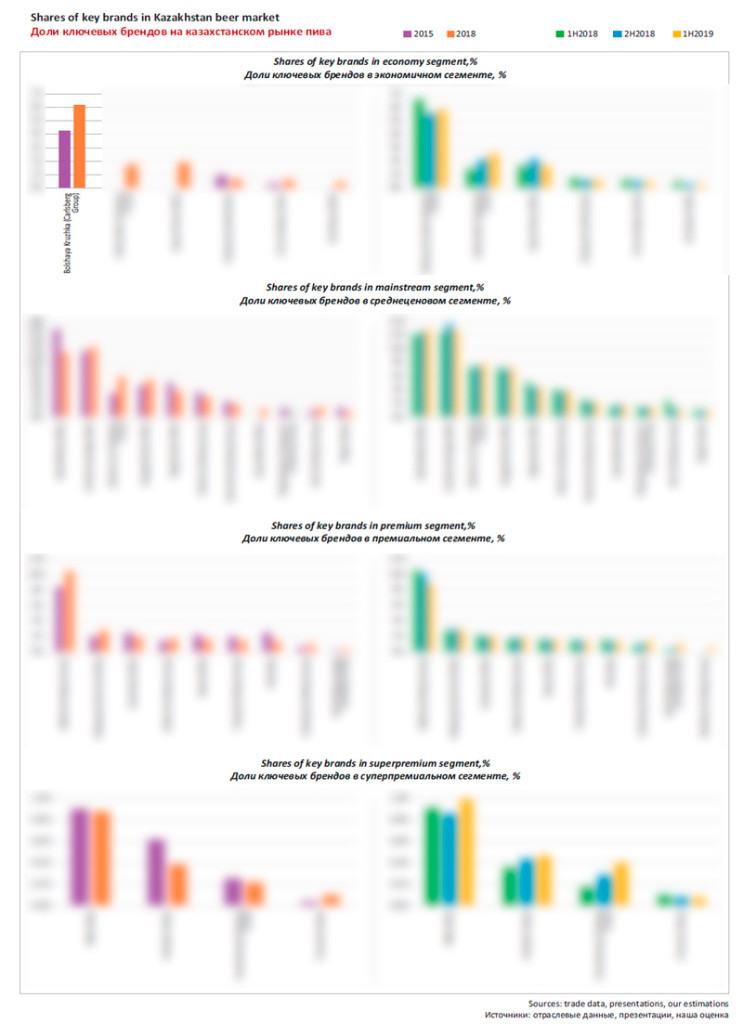
Carlsberg Kazakhstan
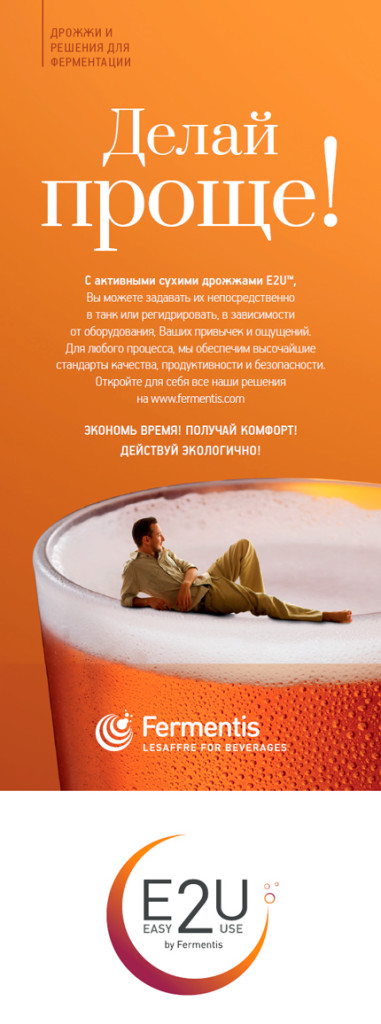 In the first half of 2019, the volumes of Carlsberg Kazakhstan output did not grow significantly (+.%) which could be considered a bad performance against the rapid growth of the industry. If not for remarkable volumes of the … in the past that bring the calculation base of the last year down.
In the first half of 2019, the volumes of Carlsberg Kazakhstan output did not grow significantly (+.%) which could be considered a bad performance against the rapid growth of the industry. If not for remarkable volumes of the … in the past that bring the calculation base of the last year down.
In other words, the sales rates in the … outpaced the … rates. According to our estimation, in the first half of 2019, they grew by …% against the same period of the last year, which is similar to the performance of the major competitor. Yet unlike the market leader, Efes Kazakhstan has … its positions against the second half of 2018, while Carlsberg Kazakhstan has … under our estimation.
Carlsberg Kazakhstan’s rapid growth over the recent several years, was based on two activity directions. The company has increased its presence in the segment of draft beer in 2015-2017 and expanded the volumes of beer import.
As yet, draft beer is considered to be the main growth driver for Carlsberg Kazakhstan. In 2018 its share in the company’s sales structure amounted to nearly ..% under our estimation and in the first half of 2019, it reached ..%. The growth rates of draft beer in the first half of 2019 ran at ..%.
In 2018 the share of import beer in Carlsberg Kazakhstan’s sales structure hit a local maximum of nearly ..% but it started to go down and in the first half of 2019 it amounted to ..%. Accordingly, natural volumes of supplies from abroad decreased too, which negatively affected the sales dynamics.
Carlsberg Kazakhstan’s sales structure by segments in the market of packed beer has changed for the worse over the recent .. months. The premium part in the total volume has decreased by … p.p. and the economy one, on the contrary, has gained … p.p. Thus, in the market of packed beer the share of the premium brands by the company has gone down by … p.p. and the share of economy brands has increased by … p.p. Besides the share of mainstream brands has grown by …p.p.
… brand which is positioned on the border between mid-price and premium segments in the Kazakh market, has seen its market share decline by … p.p. due to higher retail price. The share reduction of the major premium brand has been partially offset by other marginal brands.
In particular, the local market was influenced by launching of new brand in premium and strong beer segment. In November 2018, as the sales season ended, retail shelves were renewed by BeerKhan, which is positioned as “strong beer for strong men”. Beer containing ..% of alcohol “despite high strength and gravity has a matchless velvet, mild taste” according to the company’s description. The package design emphasizes the national identity, aggressiveness, and premium character on the new product. By spring 2019, BeerKhan share of the beer market stabilized at the level of nearly …%.
Along with the launch, the decline of … share was offset by other two brands. Fruit malt beer drink … is gaining popularity. Its share in the first half of 2019, grew to almost .%. Besides, owing to reasonable price policy, there is a growth of title brand Carlsberg market share. By midsummer 2019, it reached …% of the market.
Strengthening positions of Carlsberg Kazakhstan in the mainstream segment is mainly connected to bigger volumes of … brand. In summer its market share exceeded … making the brand the major one in the company’s portfolio. Such reshuffle is similar to what was happening in Eastern Europe where … entered the top three due to reasonable price, international positioning, and powerful advertisement.
Finally, the volumes of the economy segment have grown as well as the market share of two key brands … and …. However, … has restored its share after decline in the second half of 2018. While comparatively new brand … is experiencing a wave of rapid growth, and by the end of 2019 it can hit the level of .% of packed beer.
Shymkentskoe for Arasan
Massage about Shymkentpivo’s assets purchase by Arasan company has much impacted the brewing industry of Kazakhstan. These enterprises are located in two different ends of the country, in cities Rudniy and Shymkent. The both stand out for their big productional capacity, good market share in the local region as well as orientation for rapidly growing segment of draft beer.
Unlike Arasan, that has been rather successful at the market, Shymkentpivo has gradually been leaving the leading list (had been #. in 2007). The company faced a range of management and juridical problems described in press that finally led to production cuts and bankruptcy. In 2018 in the condition of outer management Shymkentpivo restored its output volumes to almost . mln dal (the level of 2016). In the first half of 2019, the company exceeded the market with a growth of .%.
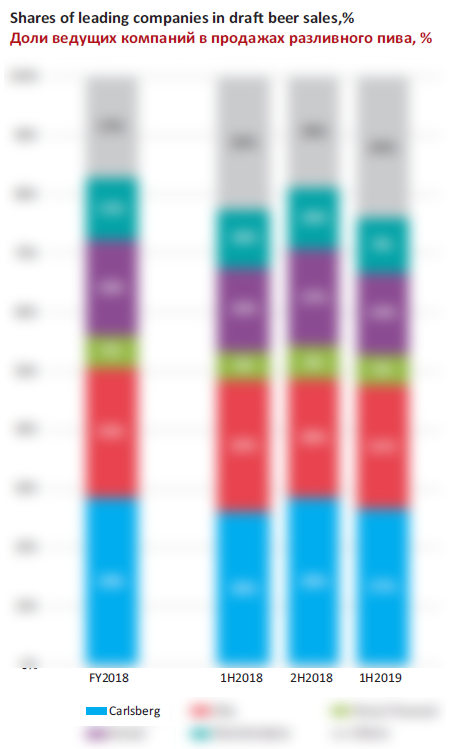
One has to note that at the moment of the article preparation, there is no official data as to acquisition of the enterprise in Shymkent, and our emails with the same question have not been answered. However, in September 2019 president of Carlsberg Kazakhstan Victor Semak told Forbes that Arasan purchased Shymkentpivo. Besides, one of official sites in the republic published (indirect) information about entering by one of Arasan employee the staff of sales division of Shymkentpivo at the beginning of 2019. Finally, the assets of Shymkentpivo were not included into long lists of pledged assets by lending bank it is putting for sales. All that leads us to the idea of purchasing of Shymkentpivo assets.
By the end of 2018, the volumes of Arasan output increased by nearly .% to . mln dal. In the total output volume of the company ..% accrues to beer in kegs. Arasan’s focusing on draft beer and affordable beer yields an advantage in the domestic region, yet remoteness of key south cities (Almaty and Shymkent) levels it out at the national scale. The regional representation of Shymkentpivo shows even bigger slant, yet it is located in densely populated area.
As far back as in 2013, Arasan started export supplies to Russia and at the same time the company took the first place by draft beer output. Due to rapid growth of this segment in Kazakhstan (and obviously, in Russia) by 2015, Arasan considerably increased the output volumes, became a regional leader but then the growth slowed down.
In 2018 the export supplies reached …. mln dal or ..% of the total output volume by the company. Typically, that company exports the bulk of produced beer in … which can be connected to the keg turnover organization problem. The volumes of … and … beer export are nearly equal. Yet the … direction seems to have hit the roof of its potential, as in the first half of 2019 the ….
In search of new growth points, Arasan obviously paid attention to riot growth of can beer at the Kazakh market. The can beer production was started in spring 2018, and it was this package along with draft beer that provided for the production grew by .% in the first half of 2019. In 2018 the company output nearly .,. mln dal of can beer and in 2019 its volume can grow twofold. Unlike the glass bottle, almost all can beer is sold on the domestic market.
Purchasing a big production site in the South of the country can give Arasan sales a new incite. Obviously, the joint company is solving the issue of logistics expenses for delivering cheap production from the North to South (and vice versa). For example, in the Northern regions Nur-Sultan (previously Astana) and Karaganda the distribution of Shymkentskoe brand has always been very low despite its high nationwide popularity.
If we speak of prospects for merging, we can say that bringing production of brands of joined portfolio to new production sites and wider representation in DIOT segment would potentially allow Arasan to dominate the draft beer market. Launching of Shymkentskoe can version could additionally expand the share at the packed beer market. And the south site can become a base for export expansion to other countries of the Central Asia.
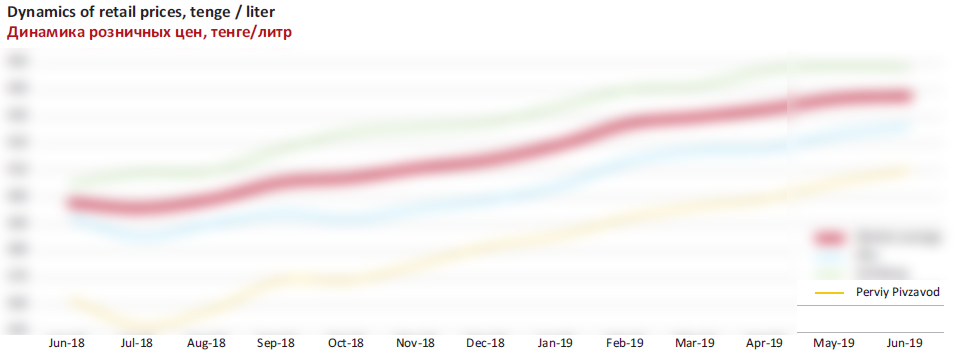
Perviy Pivzavod, Oasis CIS
In the first half of 2019, Perviy Pivzavod (PPZ) improved its market positions, both in the segments of packed and draft beer. In 2018 the sales volume of PPZ amounted to … mln dal under our estimation based on the trade balance.
In the first half of 2019 the beer output by PPZ increased by ..%. The company has substantially exceeded the industry even though the retail prices for its beer were growing rather rapidly in the ….
In accordance to the general trends in the industry, PPZ was rapidly expanding keg beer output (+..%), and currently, its share constitutes nearly ..% of the company’s output. Along with the local output, the foreign supply volume went ..% up mainly by …. Yet, the import share in the company’s sales structure is not so big, about .%.
Over the recent .. months, the gravity center in the sales structure of PPZ at the market of packed beer shifted in the marginal direction. The share of economy brands declined by . p.p. and currently equals nearly ..% of the sales, the share of mainstream beer has increased by . p.p. to ..%, while the superpremium share grew by . p.p. to ..%. Interestingly, the company is hardly presented in the … (according to our division …-… tenge for a liter) as it focuses on more expensive local and import brands.
Accordingly, the positions of PPZ at the packed beer market have been changing. The net share of company’s economy brands has decreased by … p.p. to …% (… and … experienced an equal decline). At the same time, the market positions of PPZ in the mid-price segment have improved by … p.p. mainly due to new … brand which is positioned as traditional Chinese beer. The company market share in superpremium segment has grown a little mainly thanks to license … production, but also due to net impact of the majority of import brands from Russia (production of …) and … countries.
The article materials were prepared using data by Committee on statistics Ministry of national economy. A number of estimations are based on presentations and reports provided by beer producers. The publications in issues Kursiv and Capital were used in the article preparation.
In case the information source is not provided, the data and their interpretation are our assessment based on the current trends.
We do not guarantee that the given information is absolutely correct, though it is based on data obtained from reliable sources. The article content should not be fully relied on to the prejudice of your own analysis.
To get the full article “Brewing industry in Kazakhstan 2019” in pdf (18 pages, 17 diagrams) propose you to buy it ($35) or visit the subscription page.
2Checkout.com Inc. (Ohio, USA) is a payment facilitator for goods and services provided by Pivnoe Delo.


